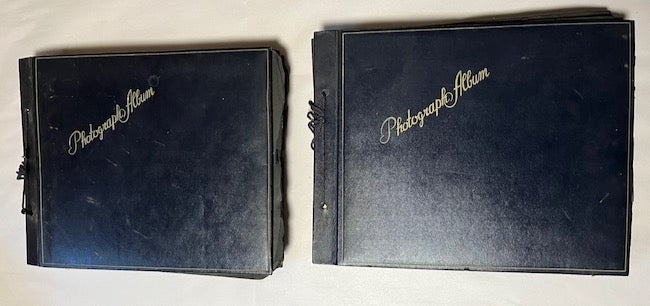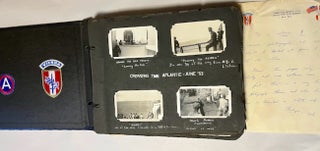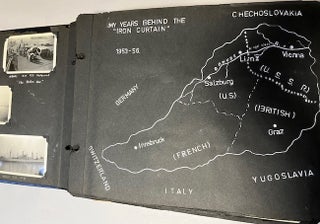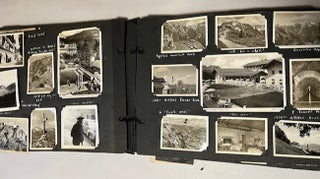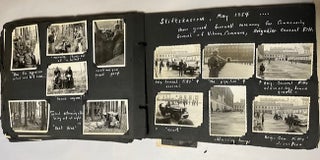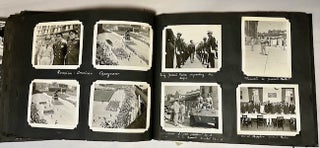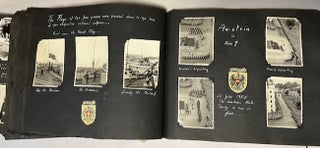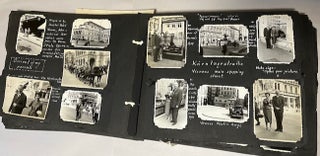My Years Behind the Red Curtain 1953-1956. Two complete album volumes of Military Service Photographs, European travel views, and ephemera including pictures of The Allied Forces pullout of Vienna in July 1955 after the Austrian State Treaty was signed.
Europe: n/a, 1953-1956.
Photograph Album. Two oblong, thick, string tied photograph albums. Dark covers. Approx. 14" x 11". Both volumes have 50 black sheets of paper completely filled on both sides with numerous personal photographs, souvenir photographs, post cards, ephemera and hand written narratives and notes in white pen. Both bindings are very fragile with several loose pages in both volumes. Some of the pictures and cards are loose and laid inside the volumes. The black sheets are chipped on the edges with small pieces flaking off. Each volume has a one page hand written explanation note by Carl Wahle on service issued paper with color "Vienna" seal illustration and color flag illustrations of America, United Kingdom. Russia and France top of the page. "7690 HQ. & SVC. CO. APO 777 US Army NY. NY." is printed in black at the center top edge of the paper. The title is taken from one of the first written title headings in volume 1. A very unique and detailed collection of photographs and ephemera detailing the personal life and service of Carl Wahle in Europe during the mid 1950's when the United States was at "Cold War" with Russia. Private First Class Wahle served with the Allied forces that controlled Vienna after World War II. There are many pictures of Carl inside the albums. He witnessed the historic departure of Allied forces from Vienna in July 1955 after the Austrian State Treaty was signed May 15, 1955. Several up close pictures taken of the Russian, French, and British Armies during the this peace keeping mission are included.
The first album contents include:
*Introductory note page to Volume 1 written by Carl
* colored embroidered shoulder patches pasted down on the inside of the front cover
*186 personal and bought photographs of European places, Military marches, service, people, etc.
*18 color photographs of Russian & American Changeover Ceremony Sept, 1953
*23 photographs from November and December 1954 of service activities, places, misc.
*a note card by Carl to his folks dated December 19, 1953
*a drawn white outlined map titled "My Trip to Berchtesgaden, Germany Dec. '53
*4 souvenir cards
*5 souvenir and 2 personal pictures of "Berchtes Jaden Salt Mines"
*61 mostly souvenir photos of the Bavarian Alps, Hitler's Eagle Nest, and Berchtas Gaden Germany in Winter 1953;
*9 mostly personal photographs taken in Paris with two photographs presumably of Carl
*a drawn map outlined in white titled "Trip to Paris, Frankfurt, Bad Ischle. - Dec. '53
*2 pages of hand written narrative of Paris France, Christmas 1953 including 2 maps and a small picture of the Eiffel tower pasted down
*color program from the Paris nightclub "Bal Du Moulin Rouge
*18 pictures of Paris
*1 page narrative of Bad Ischl Austria, December, 1953 with 6 pictures
*21 more pictures Paris and Austria with a picture portrait of Carl subtitled "Student 137 March 1953;
* pasted down Certificate - "Tactical Command USFA NCO ACADEMY Honor Graduate signed by L. J. Chase Major, Infantry and C. E. Hoy Brigadier General with Carl's note - "Graduated fourth in my class of 135 students"
*25 pictures of NCO Academy
*6 photographs of the 4th Recon Review April 1954;
*24 training and bivouac area photographs
*13 photographs of "Stiftskaserne, May 1954 Honor Guard farewell ceremony for Commanding General of Vienna Command, Brigadier General Fits"
*white drawn outlined map titled "Trip to Bavaria, Ger., Switzerland, Italy, Monaco, France, & Austria. - June 54"
*approximately 193 photographs, post cards, views and ephemera of an extended trip in Europe. Carl writes several notes about this trip including "the marvelous journey I undertook accompanied by Miss Irene Nikenoay, Mr. and Mrs. Kellman (aunt & uncle), through Austria, Germany, Switzerland, Italy, Monaco, and France (June 1954). There is a pasted down paper of travel orders and with 14 customs stamps.
The second album includes
*Introductory note by Carl stating "This is Volumn (Volume) II of my overseas photographs, and should not be examined until first reading Volume I. Please turn pages very, very slowly and with extreme caution. I request this, due to the fact I have written with white ink on every page and also because of the large amount of photographs therein. Thank you, Carl."
*6 photographs "Command Inspection by Brigadier Gen. Nutter
*20 scenes within the Stiftskaserne
* 51 pictures of service in Europe including views of the former Nazi World War II headquarters,, Russian military zones, and photographs of politicians Senator Estes and Congressman Daniel Reed
* 44 pictures of "Soviet - American change over ceremony Vienna dated 1 Sept 1951 (should be later than 1951?)
* 26 photographs of Carl's parents arrival and travel in Vienna
*one page with one nice color illustrated note card pasted down
*8 pictures "British - American change over Ceremony Heroes Square 1 Nov 1954"
*19 service photographs taken October, 1954
*large photograph of the "Flak tower, Stiftskaserne" made by the Nazis
* 86 views and cards from a trip made in October, 1954 to Frankfurt, London, Rotterdam, Brussels, Luxembourg, and Stuttgart
*3 pictures of a newly wedded couple (unnamed)
*61 more pictures of the October 1954 trip
* a small color embroidered note card dated May 15th with a note written inside "Belvedere Palace.... this baroque structure, which was constructed in the 18th century for Prince Eugene, was the scene for the signing of the Austrian State Treaty. On this day a new era began for Austria."
*large photograph of the "Austrian Landscape"
*56 pictures and views of places in Vienna, a British Inspection at Schonbrunn Barracks, Vienna Radio Station, "International weapons match", a picnic, an Austrian dance, boxing match, change over ceremonies involving American-British, French-British, American-Russian
* a nice holiday greeting card printed in German? from Irene Nikenday
*16 pictures, cards, ephemera from Austria
*4 pictures Russian-American Changeover
*4 pictures General Nutter farewell ceremony
*5 misc pictures armed forces day, inspection in ???, 2 American Generals, a miniature photograph of Carl "X-9", a wedding picture
*41 pictures of French, American, Russian military units, drill teams, marches, etc. dated 28 July 1955 "was the date the Austrian State Treaty came indo? foree....? and another note "Austria is Free! 28 July 1955 The Austrian State Treaty is now in force..."
* a large mounted picture with the sun shining through a tree forest titled "Morning"
* a very large color picture of 3 cows
*44 more pictures and cards of various unnamed places to complete the end of Volume 2. Fair. Item #25372
From the United States Department of State:
Austrian State Treaty, 1955
On May 15, 1955, representatives of the governments of the Soviet Union, Great Britain, the United States, and France signed a treaty that granted Austria independence and arranged for the withdrawal of all occupation forces. These governments signed the agreement with the understanding that the newly independent state of Austria would declare its neutrality, creating a buffer zone between the East and the West. The Austrian State Treaty was the only treaty signed by both the Soviet Union and United States in the decade after the 1947 Paris Peace Treaties, and it marked the only Cold War era withdrawal by the Soviet Union from a territory it occupied.
The Austrian situation was unique in postwar Europe. In 1938, it had been the only nation to be annexed in its entirety by Nazi Germany, a fact that raised consistent questions during the war about the extent to which the country was a victim of Nazi aggression or whether it had been a collaborator. At the Potsdam Conference in 1945, the Allies agreed that they would jointly occupy Austria in the postwar period, dividing the country and its capital Vienna into four zones as they planned to do with Germany and Berlin. The Soviets also demanded reparations from Austria, a request that was dropped due to the country's non belligerent status, but the United States did agree that the Soviet Union would be entitled to any German assets in the Soviet occupation zone. In contrast to Germany, the Austrian government continued to exist in the postwar period and govern, although the Four Powers could veto any new legislation if they unanimously agreed to do so. This arrangement was maintained until the withdrawal of the occupying powers upon the completion of the Austrian State Treaty.
The breakdown of the wartime "Grand Alliance" and the emergence of the Cold War led to the Austrian occupation lasting far longer than anyone anticipated. Negotiations over the final status of Austria began in 1947, when half of fifty-nine proposed articles for a treaty were agreed upon. At the first meeting, the foreign ministers agreed to name the agreement under negotiation the Austrian State Treaty, not the Austrian Peace Treaty, to acknowledge that Austria's involvement in the war had not been voluntary and that the treaty was therefore not to end a war, but to reestablish an independent state. The principle sticking point during the 1947 negotiations was the issue of German assets: how they were defined and just how much compensation the Soviet Union was entitled to take. The Soviet occupation forces had seized control of factories, railroads, as well as oil and shipping concerns, all of which had been under Nazi control at one point or another, and only offered to sell them back to the struggling Austrian provisional government at exorbitant prices. As a solution to this situation, France suggested a revenue-sharing plan, in which some profits from the formerly German-held industries would be sold back to Austrians and some would operate independently, with the Austrian State and occupying powers sharing their revenue, but then the Soviet Union refused the treaty, claiming some Austrian territories on behalf of the government of Yugoslavia. The parties finally reached an agreement in 1949 in which the West would offer economic concessions to the Soviet Union in exchange for the Soviet relinquishment of Yugoslav claims. Just when a deal appeared imminent, the Soviet Union again opted not to sign; in fact, at several points throughout the process the Soviet Union delayed completion of the treaty while it reconsidered what benefits it hoped to gain from the agreement.
Between 1950 and 1953, tense Cold War relations and the existence of a hot war in Korea also contributed to stalling the talks on the Austrian situation. Then, after the death of former premier Joseph Stalin in 1953, his successors in the Soviet Union launched a "peace offensive" to try to decrease international tensions. Although there were some concrete indications of the new policy, such as relaxed controls in East Berlin and the newfound willingness of the Chinese to discuss Korean War POW exchanges after Chinese leaders visited Moscow, U.S. President Dwight D. Eisenhower stated that he would only agree to holding a summit meeting with the Soviet Union if there were several clear indications that Soviet actions would match its rhetoric of peace. One of the examples he named was the completion of the Austrian State Treaty. Even before negotiations on the treaty restarted, there were indications that Soviet policy toward Austria was liberalizing, as it loosened restrictions on the press and travel in and out of its sector and also worked to establish formal diplomatic relations with the Austrian Government.
With the German assets question all but settled in the last set of draft treaties, the question holding up the negotiations at this stage was the issue of Austrian neutrality. The Austrian Foreign Minister went through the neutral government of India to inform the Soviet Union that if a treaty was signed, independent Austria would also remain neutral, staying out of NATO or other defensive arrangements. Eisenhower was against neutrality on principle, and he was both angered by this maneuver and hopeful that Austrian neutrality could still be prevented. One particular danger was that West Germans, anxious for their nation's own reunification, would follow the Austrian example and offer their neutrality in an effort to expedite unification. German neutrality would have greater implications for American security plans in Europe than Austrian neutrality would. In late 1954, the West German Government and the Western powers at last reached an agreement under which Germans would rearm under the NATO command, reassuring the United States.
Finally, in April of 1955, and after substantial debate on both sides, representatives of the Austrian Government traveled to Moscow and returned just four days later with a complete treaty that outlined compensation to the Soviet Union for German assets and the nature of Austrian neutrality. U.S. officials demanded two changes in the treaty regarding the upper limit placed on Austrian armed forces and the removal of a clause on voluntary repatriation of displaced persons that they feared could be used by the Soviet Union to force anticommunist refugees to return to East Bloc countries. The Soviets conceded on both points. The overall terms of the treaty were less favorable to the Soviet Union than previous proposals, but the timing was right for the USSR to initiate its withdrawal from Austria. On May 15, representatives from Britain, France, the United States, and the Soviet Union signed the Austrian State Treaty, ending seventeen years of occupation by foreign troops. As promised, the newly-independent nation declared and maintained its neutrality for the remainder of the Cold War.
Price: $800.00



